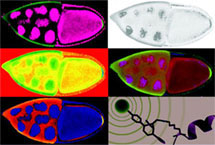 Research undertaken by Jason Chin’s group, in the LMB’s Centre for Chemical and Synthetic Biology (CCSB), part of the Protein and Nucleic Acid Chemistry Division, has successfully developed a novel and versatile technique to identify proteins produced in a particular set of cells at a particular time.
Research undertaken by Jason Chin’s group, in the LMB’s Centre for Chemical and Synthetic Biology (CCSB), part of the Protein and Nucleic Acid Chemistry Division, has successfully developed a novel and versatile technique to identify proteins produced in a particular set of cells at a particular time.
Individual sets of cells in the body of an animal are specialised to do different things. To gain insight into many biological processes, it is important to understand the differences between cells in the body. One key thing that differs between cells is the set of proteins they produce. Identifying the proteins synthesised at specific times in cells of interest is vital in helping to study cellular functions and dynamic processes.
Work, led by Tom Elliott, Fiona Townsley and Ambra Bianco, has led to the development of a method to tag the proteins in specific cells in the body produced at particular times. Using Drosophila melanogaster, the common fruit fly, as a model organism they have incorporated unnatural amino acids into proteins in order to label, image and identify proteins in specific cells in a developing fly under physiological conditions. They developed an approach that takes the way cells normally make proteins and added a ‘highlighter’ to the proteins synthesised in particular cells, so that proteins from just those cells light-up. This groundbreaking method allows us to define the proteins produced in specific cells at specific times. It is the first time that tagging of proteins from defined sets of cells in a whole fly has enabled the identification of proteins produced in a particular set of cells at a particular time.
The development of this novel and versatile technique involved a very broad interdisciplinary approach, and the method has the potential to become widely used in many different fields.
This work was supported by the Medical Research Council and the European Research Council